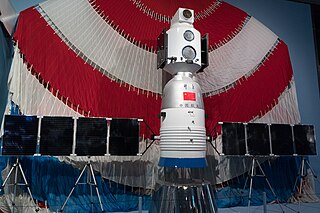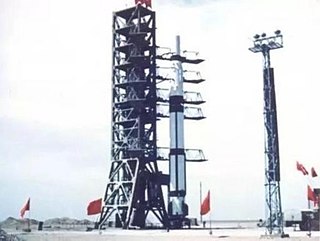
Shenzhou 5 was the first human spaceflight mission of the Chinese space program, launched on 15 October 2003. The Shenzhou spacecraft was launched on a Long March 2F launch vehicle. There had been four previous flights of uncrewed Shenzhou missions since 1999. China became the third country in the world to have independent human spaceflight capability after the Soviet Union and the United States.

Jiuquan Satellite Launch Center is a Chinese space vehicle launch facility (spaceport) located between the Ejin, Alxa, Inner Mongolia and Hangtian Town, Jinta County, Jiuquan, Gansu Province. It is part of the Dongfeng Aerospace City. Because 95% of JSLC located in Jinta County, Jiuquan, the launch center is named after Jiuquan. The launch center straddles both sides of the Ruo Shui river.

The space program of the People's Republic of China is about the activities in outer space conducted and directed by the People's Republic of China. The roots of the Chinese space program trace back to the 1950s, when, with the help of the newly allied Soviet Union, China began development of its first ballistic missile and rocket programs in response to the perceived American threats. Driven by the successes of Soviet Sputnik 1 and American Explorer 1 satellite launches in 1957 and 1958 respectively, China would launch its first satellite, Dong Fang Hong 1 in April 1970 aboard a Long March 1 rocket, making it the fifth nation to place a satellite in orbit.

Chang'e 1 was an uncrewed Chinese lunar-orbiting spacecraft, part of the first phase of the Chinese Lunar Exploration Program. The spacecraft was named after the Chinese Moon goddess, Chang'e.
As of 2024, the People's Republic of China has sent two women to space: Liu Yang and Wang Yaping, both taikonauts in the People's Liberation Army Astronaut Corps (PLAAC). Liu Yang, China's first female taikonaut, first flew in 2012 aboard Shenzhou 9, and since then three additional missions have included female crew members: Shenzhou 10, 13, and 14. According to the China National Space Administration, many women also hold leadership positions in the Chinese space program, and actively contribute to the Chinese space effort.

The China Aerospace Science and Technology Corporation (CASC) is a main contractor for the Chinese space program. It is state-owned and has subsidiaries which design, develop and manufacture a range of spacecraft, launch vehicles, and ground equipment. It also has a division for strategic and tactical missile systems.

Long March 5, or Changzheng 5 (CZ-5), and also by its nickname "Pang-Wu", is a Chinese heavy-lift launch vehicle developed by the China Academy of Launch Vehicle Technology (CALT). It is the first Chinese launch vehicle designed to use exclusively non-hypergolic liquid propellants. It is the fifth iteration of the Long March rocket family.

The Chinese Lunar Exploration Program, also known as the Chang'e Project after the Chinese Moon goddess Chang'e, is an ongoing series of robotic Moon missions by the China National Space Administration (CNSA).

The Wenchang Space Launch Site is a rocket launch site located in Wenchang on the island of Hainan, in China.

The following outline is provided as an overview of and topical guide to space exploration.

Tiangong-3 was a proposed Chinese space station, part of the Tiangong program. The China National Space Agency (CNSA) was originally expected to launch Tiangong-3 around 2015, following the launch of the Tiangong-2 test laboratory, originally planned for 2013. The goals for the Tiangong-2 and Tiangong-3 laboratories were merged, and the latter was therefore not ordered. The first module of the third station of the Tiangong program, Tiangong space station, was eventually launched in 2021.
Sino Satellite Communications Co., Ltd. known also as SinoSat is a Chinese company.

Tianhe, officially the Tianhe core module, is the first module to launch of the Tiangong space station. It was launched into orbit on 29 April 2021, as the first launch of the final phase of Tiangong program, part of the China Manned Space Program.

Ma Xingrui is a Chinese politician and aerospace engineer who is the Communist Party secretary of Xinjiang. Prior to that, he had served as the Vice Minister of Industry and Information Technology, Head of the Political and Legal Affairs Commission of Guangdong, Communist Party Secretary of Shenzhen, Deputy Party Secretary of Guangdong, and Governor of Guangdong. Ma is a member of the Politburo of the Chinese Communist Party.

Chen Qiufa is a Chinese aerospace engineer and politician of Miao ethnic heritage. He is the Communist Party Secretary and the former Governor of Liaoning province. He formerly served as Director of the China Atomic Energy Authority, Director of the China National Space Administration (CNSA), and Vice-Minister of Industry and Information Technology.

The International Lunar Research Station (ILRS) (Chinese: 国际月球科研站) is a planned lunar base currently being led by Roscosmos and the China National Space Administration (CNSA). The ILRS will serve as a comprehensive scientific experiment base built on the lunar surface or in lunar orbit that can carry out multi-disciplinary and multi-objective scientific research activities including exploration and utilization, lunar-based observation, basic scientific experiment and technical verification, and long-term autonomous operation. Statements from Roscosmos and CNSA underline that the project will be "open to all interested countries and international partners."

The Planetary Exploration of China, also known as Tianwen, is the robotic interplanetary spaceflight program conducted by the China National Space Administration (CNSA). The program aims to explore planets of the Solar System, starting from Mars, and will be expanded to Jupiter and more in the future.
The Wenchang Commercial Space Launch Site, located at Wenchang, Hainan, is China's first commercial space launch site, and 5th space launch site. The launch site started construction in July 2022, and is expected to be put into service in 2024.

The People's Liberation Army Aerospace Force is an arm of the People's Liberation Army. It was established on 19 April 2024. Chinese state media has also referred to it as the People's Liberation Army Space Force.

















